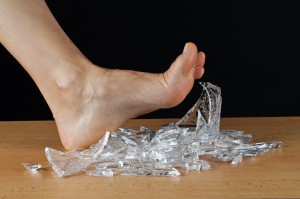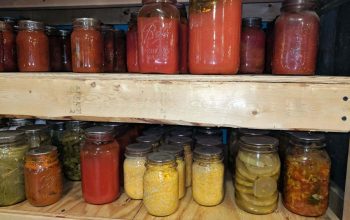In survival scenarios, the family medic can expect to be called upon to treat various injuries and illnesses. They’ll be the highest medical asset left if access to modern medical care is no longer an option., Therefore, it’s important to be ready to provide care from beginning to end, even when the healing process goes awry and leads to wound infections.
Most wounds these days don’t become infected. Off the grid, however, it’s another story. What circumstances can you think of where a wound incurred in a primitive environment wouldn’t be dirty?
Skin is the body’s armor. When it’s breached, microbes can invade and cause inflammation in soft tissues (known as “cellulitis”) or accumulations of pus (known as “abscesses”). These conditions are generally treatable today due to the availability of antibiotics. Without them, however, any bacterial invasion may become life-threatening, especially if it enters the circulation. The end result might affect the entire body (called “sepsis”) and may be fatal.
HOW DO WOUND INFECTIONS OCCUR?
The bacteria that can cause wound infections are living on your skin right now. Normal skin inhabitants include Staphylococcus and Group A Streptococcus. They do no harm until the skin is broken; once that happens, they enter deeper spaces where they don’t belong. In recent years, a resistant bacterium called MRSA (Methicillin-Resistant Staphylococcus Aureus) has arisen which causes infections resistant to the usual antibiotics. More rarely, other species of bacteria can cause infection, including flesh-eating bacteria like Vibrio vulnificus.
SIGNS AND SYMPTOMS OF WOUND INFECTIONS
An emerging wound infection must be recognized as early as possible. You’ll commonly see local signs and symptoms like:
- Redness, usually spreading towards torso
- Swelling in the area of infection (often appearing shiny and causing a sensation of tightness)
- Heat in the area of the infection compared to non-affected areas
- Drainage of pus or cloudy fluid from the area of the infection
- Foul odor coming from the area of infection
- Discomfort in the area of infection
Once the infection enters the bloodstream, general body symptoms predominate, including:
- Fever and Chills
- Exhaustion (fatigue)
- General ill feeling (malaise)
- Muscle aches (myalgia)
- Joint stiffness caused by swelling of the tissue over it (less common)
- Altered mental status
Left untreated, extreme cases lead to shock, organ failure, and, eventually, death.
TREATMENT OF WOUND INFECTIONS
First, I should mention that wound infections aren’t generally contagious, unless you have an open wound yourself and contaminate it with material from the patient’s wound.
Cellulitis commonly develops in an extremity, such as an arm or leg. This is where minor injuries occur, especially in those who, off the grid, will be forced to perform activities of daily survival to which they aren’t accustomed. Chopping wood for fuel is an example. When was the last time you swung an axe?
Simple actions can help. It’s helpful to keep the limb elevated above the level of the heart. Warm or cool compresses or soaks to the affected area help inflammatory fluid to drain, and the use of ibuprofen (Advil) or acetaminophen (Tylenol) can decrease pain, discomfort, and fever.
CLEANING OPEN WOUNDS
A thorough cleaning to flush out debris, bacteria, blood, and other contaminants from the wound is important. A solution of “normal saline,” so-called for its resemblance to the salt content of blood, is helpful. You can buy it commercially or make it yourself by:
- Filling a pot with a lid with a liter of water.
- Add 2 teaspoons of salt.
- Boil for 15 minutes.
- Let cool with the lid on.
Use immediately on the wound or store in a sterile canning jar with a sterile lid. If sealed properly, it can last up to a month.
During WWI, a mixture known as Dakin’s solution was used to treat and prevent infection in open wounds; it is still in use in certain situations today:
To make Dakin’s solution:
- Wash your hands with soap and water.
- Measure out 32 ounces (4 cups) of tap water and pour into a clean pan.
- Boil water for 15 minutes with lid on the pan, remove from heat.
- Add ½ teaspoonful of baking soda to the boiled water.
- Measure one tablespoon plus two teaspoons (24ml) of plain bleach and add it to the water.
- Place the solution in a sterile jar. Close the sterile lid tightly.
- Cover the entire jar with aluminum foil to protect it from light
It’s said that Dakin’s solution can be stored for one month at room temperature (sealed and covered), but might best be prepared and used immediately as the need arises.
Packing the wound “wet-to-dry” with moist (not soaked) dressings up to the level of the skin and dry above should be performed at least daily.
To determine the progress of the infection, use a felt marker to demarcate the borders of the redness around the wound. If healing well, the redness will eventually recede. If worsening, it will spread.
ANTIBIOTICS
In some cases, the body might resolve cellulitis on its own. When resolution of the infection isn’t forthcoming, however, treatment usually includes the use of antibiotics. These can be topical, oral, or intravenous. Topical therapy helps more to prevent infection than cure it.
As most cases of cellulitis are caused by bacteria, they should improve and disappear during a 7-14-day course of therapy with medications in the penicillin, erythromycin, or cephalosporin families. Amoxicillin and ampicillin are particularly popular. MRSA cellulitis can be treated with clindamycin and the sulfa drug combination of sulfamethoxazole/trimethoprim (SMX-TMP). It’s important to complete the full course of therapy.
Adult dosing:
Penicillin, amoxicillin, cephalexin, or ampicillin: 250-500 mg orally four times a day for 7-14 days (Amoxicillin also comes in 875 mg).
Clindamycin: 150-300 mg orally three times a day for 7-10 days.
SMX-TMP: 800/160 mg twice a day orally for 7-10 days.
Those allergic to penicillins can still take clindamycin or SMX-TMP. It should be noted that not all sources will recommend the same dosage, frequency, and duration of therapy for a particular drug. In resistant infections like MRSA, combination therapy with SMX/TMP and Cephalexin 500 mg orally four times a day for 7-14 days may be necessary.
Prior to the advent of antibiotics, silver was used to prevent and treat wound infections. Silver ointments and creams are available commercially.
(Note: As with all medications, the longer the therapy and the higher the dose, the more likelihood that adverse reactions may occur. A much more comprehensive discussion of antibiotics can be found in “Alton’s Antibiotics and Infectious Disease: The Layman’s Guide,” and online at drugs.com or rxlist.com.)
Joe Alton MD




 irrigating the open wound
irrigating the open wound

 Dr. Alton
Dr. Alton



